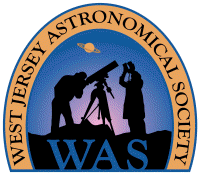SJAstro Page Index |
Mercury 2020, last sighting
November 8 | Weather Links
Comet C/2020 F3 (NEOWISE)
July 7, 2020
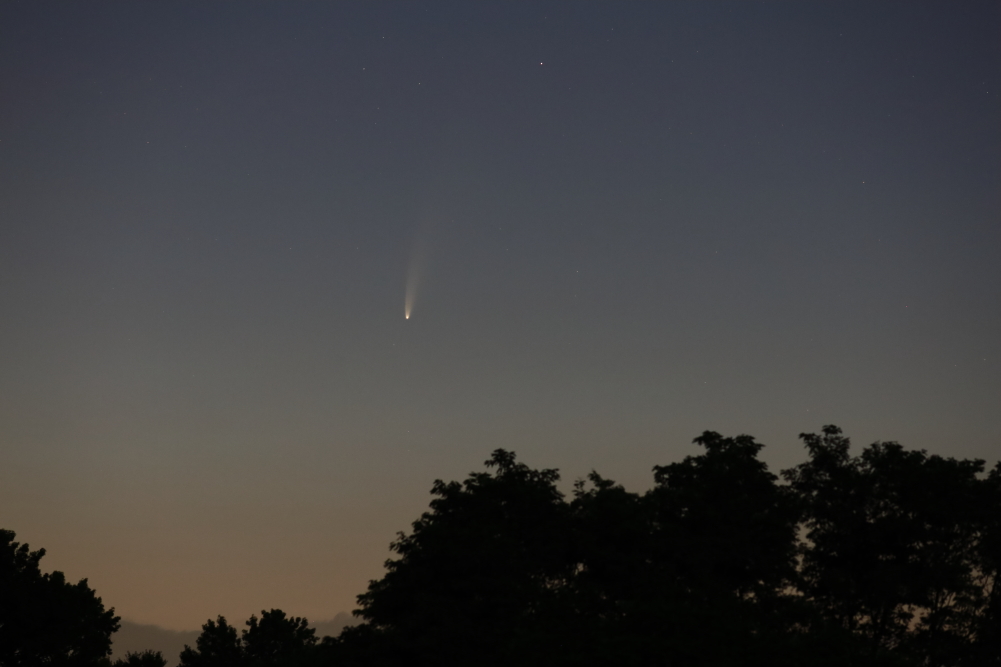
|
It was worth the wait to finally see comet
C/2020 F3 (NEOWISE) on
the morning of July 7, 2020,
from Swede Run in Moorestown, NJ. I had been out four of the five
previous mornings for a look, only to be foiled by clouds along the
horizon. This morning, July 7, it was generally clear and the comet was
quickly spotted at 4:06 am EDT with 15x56 binoculars, in which it
appeared much as it does in the picture; most notably, it showed a
prominent tail (that's not typical of the majority of comets I see, let
alone from a suburban location). This snapshot was captured at 4:22 am with a Canon EOS RP mirrorless digital camera and a
Canon 200 mm f/2.8L telephoto lens on a fixed tripod. It's a single raw
frame exposed 1
second at f/3.5, ISO 3200, daylight white balance. Some minor
brightness/contrast adjustments were made with Canon's
Digital Photo Professional 4, then it was saved as a JPEG for this web page.
It's uncropped for a field 10.3° wide x 6.9° high, with the comet's head at
5.6° altitude. Astronomical twilight
began at 3:38 am and sunrise would be at 5:39 am. The star above-right
of the comet is magnitude 2.7 Theta Aurigae, which at the time was
3°2.5' from the comet's head.
The image below is from the same raw image as the
one above. Besides cropping to a field 1.3° wide x 1.7° high to magnify
the comet, brightness, contrast and color balance were independently adjusted
from the raw file. The purpose was to see if a darker central
streak in the tail was visible, which is perhaps caused by the "shadow of
the nucleus" (by David Seargent) and has been a topic of discussion recently in comet
circles. It's not prominent here, but there is a slight dark streak in the
tail above the coma.
|
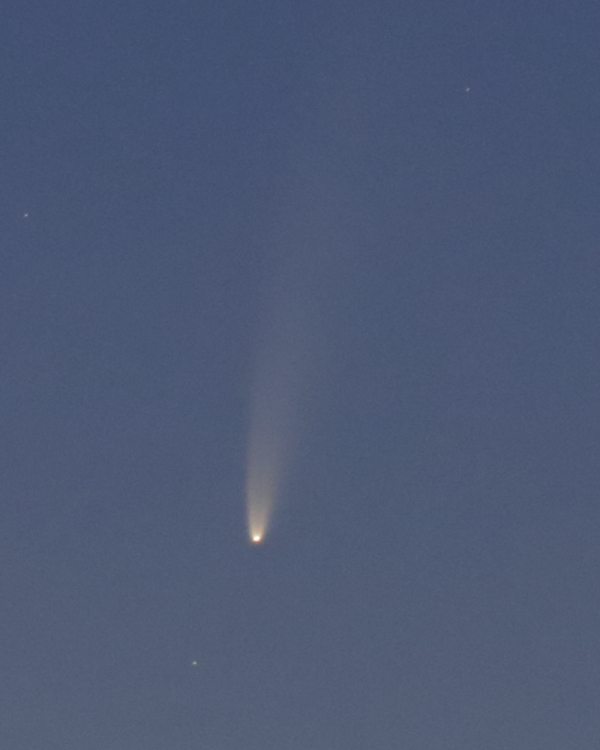
July 12, 2020
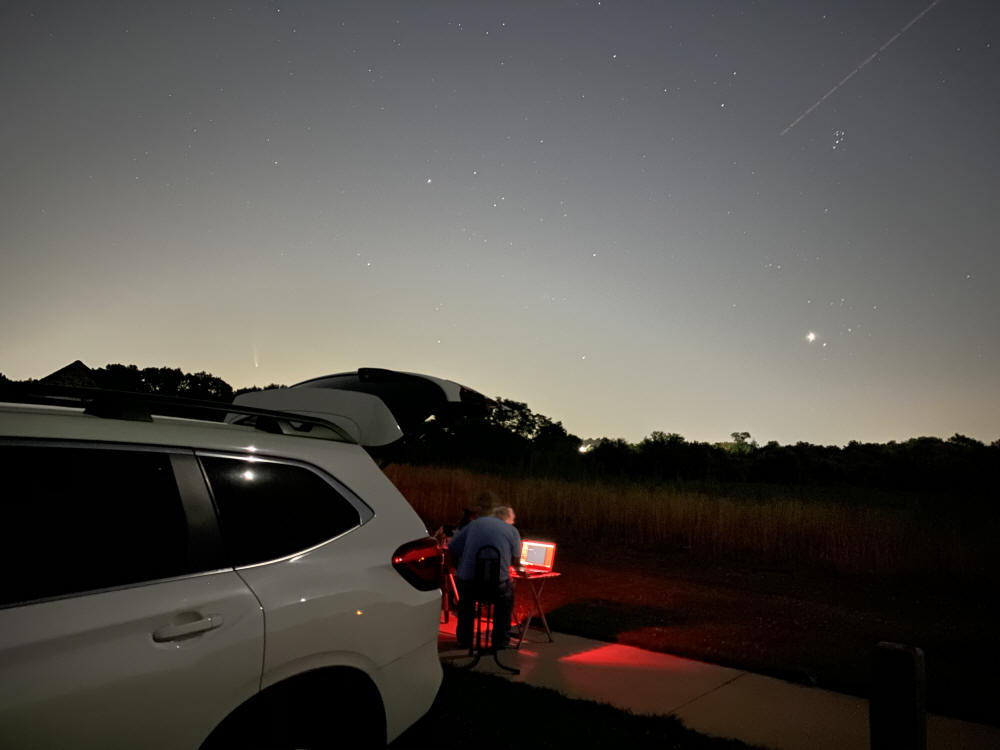
|
On July 12, 2020,
eight members of the West Jersey Astronomical Society
(and a random visitor)
gathered under a
beautiful sky on an autumn-like morning at Swede Run in Moorestown, NJ, to observe comet
C/2020 F3 (NEOWISE).
In a sense, it was the de facto July 2020 Member Star Watch since the
official event at Atsion in Wharton State Forest the prior evening had
been cancelled due to coronavirus concerns.
As it had been previously for me on
Tuesday, July 7, 2020, the
comet was a fine sight in 15x56 binoculars. It had a 1.5° tail extending
to near 16 Lyncis (although the head was still in Auriga). More
impressively, I was able to see the comet, the head and the tail,
almost easily with unaided eyes between 4:10 and 4:40 am EDT. How
splendid it was to be under a clear sky after looking so often at clouds
this month.
This snapshot was captured at 4:03 am on
Sunday, July 12, 2020, with an
iPhone 11 on a fixed tripod. It's a single unprocessed
frame exposed 1
second at f/1.8, ISO 2500, 4.25 mm focal length. Except for size
reduction, it's straight from the phone. It shows
Al Meloni, president
of the WAS, as he operates his imaging rig with the comet in the
background sky. The comet's head is at
5.6° altitude after rising at 2:58 am. Astronomical twilight began at
3:44 am and sunrise would be at 5:42 am. Mouseover for labels.
Note: There's an
aircraft streak in the upper-right corner of the frame. Even though the
EXIF data indicated a 1 second exposure, the streak seems much longer
than one second and the camera setting at the time suggested 30 seconds
exposure (albeit, I only started using this new phone a few days
earlier, so I was not exactly an expert yet). It may also be that Apple
is shrouding some of the processing mysteries it uses in the iPhone 11.
Update, July 14, 2020:
The comet was observed again at Swede Run on the evening of
Monday, July 13, my
first evening sighting. It was picked up with 15x56 binoculars at 9:50
pm in a hazy sky (typical of July), which reduced visibility
considerably compared to the crisp sky on the morning of July 12, but
the tail was still obvious. The view in my 88 mm apo spotting scope at
25 to 60x was disappointing and it could not be seen with unaided eyes.
The following morning,
Tuesday, July 14, 2020,
I was back to Swede Run, although I failed to set my alarm, so I was
running a bit late. The weather was nice with a crisp clear sky, similar
to Sunday, July 12, but by time I arrived at 4:40 am, twilight was
already brightening. I couldn't find the comet quickly in the 15x56s, so
I lined up with a scope that was pointed towards it and then found it in
short order. It showed a nice head and tail, but I could not see it
convincingly with unaided eyes. My main objective was to see the comet
at both ends of a single night, after sunset and before sunrise, in this
case, July 13 & 14. That goal was achieved and it was the first time
since January 2007 when I did it with comet C/2006 P1 (McNaught).
Update, July 20, 2020:
The comet was observed again on the evening of
Saturday, July 18, from the street at the end of
my driveway (under a streetlamp!) in Maple Shade, NJ. With 15x56
binoculars at 10:35 pm EDT, and guided by the bowl of the big Dipper, I
easily found the fuzzy head, and could see a faint tail extending
upwards. I then headed to Swede Run in Moorestown, NJ, but even though
it's slightly darker there, my initial view was inferior to the view at
home, and then it soon disappeared altogether into haze above the
horizon (it was a typical muggy July evening). Then on
Monday, July 20, 2020,
I was back to Swede Run, this time arriving just after 9 pm (which is
early for me; sunset was at 8:24 pm, astronomical twilight would end at
10:18 pm). I promptly found the comet (head and tail) at 9:09 pm in
relatively bright twilight since the atmosphere in that direction was
still clear and haze free. The position was easy to establish about 5°
to the left of 26 and Theta UMa below the Bowl of the Big Dipper.
However, visibility did not improve as the night wore on and twilight
deepened. The comet sank into haze and even disappeared at times as I
continued to watch until 10:45 pm when I left. There was a low ISS
(International Space Station) pass from 10:06 pm in the NW to 10:10 pm
in the NNE (peaking at 14° altitude and magnitude -0.6 per
Heavens-Above). However, it didn't emerge from the haze until about
10:08 pm in the north (under Polaris).
|
Penumbral Lunar Eclipse
July 5, 2020
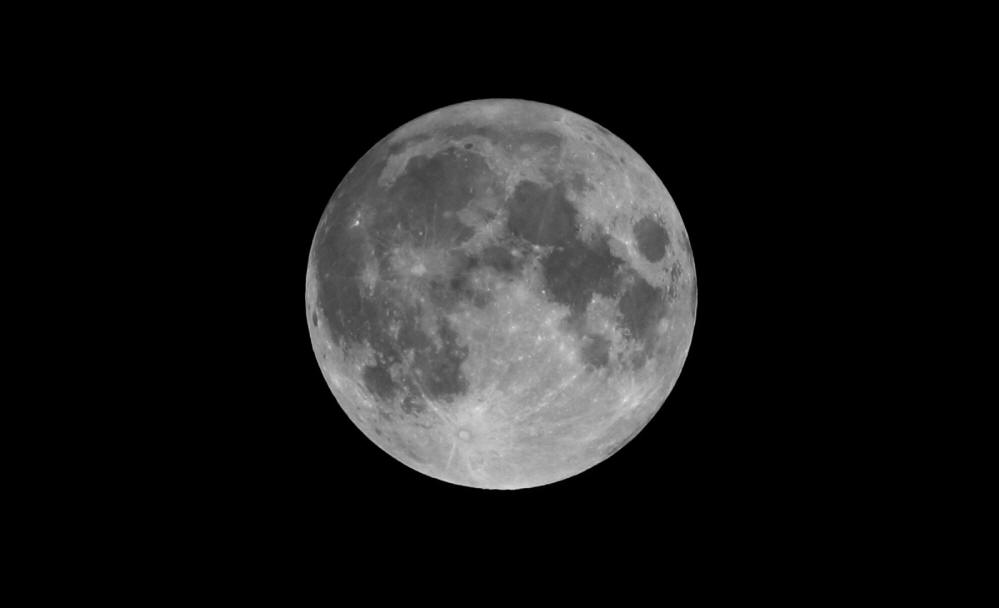
|
The Earth's Moon
entered the outer portion of the Earth's shadow, the penumbra, late on
the evening of
July 4, 2020, about 11:04
pm EDT, and reached maximum eclipse at 12:30 am on July 5, but only
about a third of the Moon (at the top) was covered, so the eclipse was
barely visible at best. Full Moon would occur at 12:44 am and the Moon
would transit the local meridian at 1:06 am, 25° altitude (1:00 am is astronomical
midnight during Daylight Time). Indeed, this image (with contrast increased), a
binocular view and a view with unaided eyes all showed no real sign of the
penumbra on the lunar disc to this observer. This corresponds with Fred
Espenak's prediction in a
Spaceweather article.
The image was captured on
July 5, 2020,
at 12:30 am EDT from my backyard in Maple Shade, NJ, with a Canon EOS RP mirrorless digital camera and a
Canon 400 mm f/5.6L telephoto lens on a fixed tripod. It's a single raw
monochrome frame exposed 1/800
second at f/11, ISO 800 (which coincidently corresponds to be the "Looney
Eleven"
rule-of-thumb). Contrast was increased using Canon's
Digital Photo Professional 4, then it was cropped to about a quarter of
the original linear dimensions for field about 1.3°
wide x 0.8° high and saved as a JPEG for this web page. |
Venus in the Morning Sky
June 14, 2020
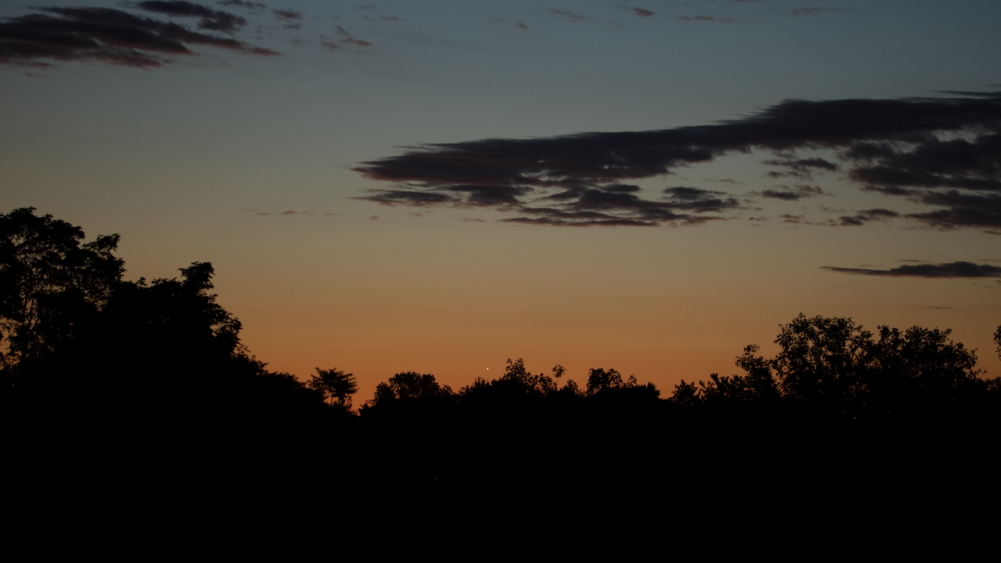
|
The planet
Venus, gleaming at
magnitude -4.2, was captured on
June 14, 2020,
at 4:50 am EDT (1.8° altitude) from Swede Run in Moorestown, NJ, with a Canon EOS RP mirrorless digital camera and a
Tamron 150 to 600 mm
f/5-6.3 zoom lens (on a fixed tripod) set to 150 mm focal length. It's a single raw frame exposed
1/30
second at f/5.0, ISO 1600 and daylight white balance. Using Canon's
Digital Photo Professional 4, no adjustments were made besides cropping
to 90% of the width x 76% of the height (to a 16:9 ratio) for a field 12.3° wide x
6.9° high, then finally resizing to 1000 x 563 pixels for this web page. Mouseover for
a label.
Venus was at inferior
conjunction (i.e., between the earth and the sun) on June 3, 2020, and
is now emerging in the morning twilight. I had spotted it after sunset,
then during the daytime, before inferior conjunction, the most notable
sighting being on June 1 at 4:14 pm EDT with my 88 mm apo spotting scope at 60x when it
was just 3.1° east of the sun, 0.1% illuminated.
The sun was safely blocked by an
overhead solar panel. The delicately
thin crescent was sublime, and in moments of best seeing, the entire rim
of the planet glowed from light scattered through its thick white
atmosphere. Of the multitude of Venus-near-conjunction images in Spaceweather's photo gallery,
and elsewhere, none could match the visually thin
crescent I saw with my own eye. The initial sighting of this apparition
was on August 24, 2019, with the 15x56s at 3 pm EDT, 10 days
after superior conjunction.
Because of weather, it wasn't until June 7, 2020,
that I saw Venus in the daytime again, with 15x56 binoculars, a
perfunctory view at 6.3° solar elongation and 0.6% illuminated,
but now on the western side of the sun, so it had become a
morning object. On June 13, I spotted Venus in brightish morning twilight at Swede Run with the 15x56s at 4:58 am,
technically nighttime since the sun wouldn't rise until 5:31 am. I was
determined to return on June 14 and get some snapshots, as I did.
|
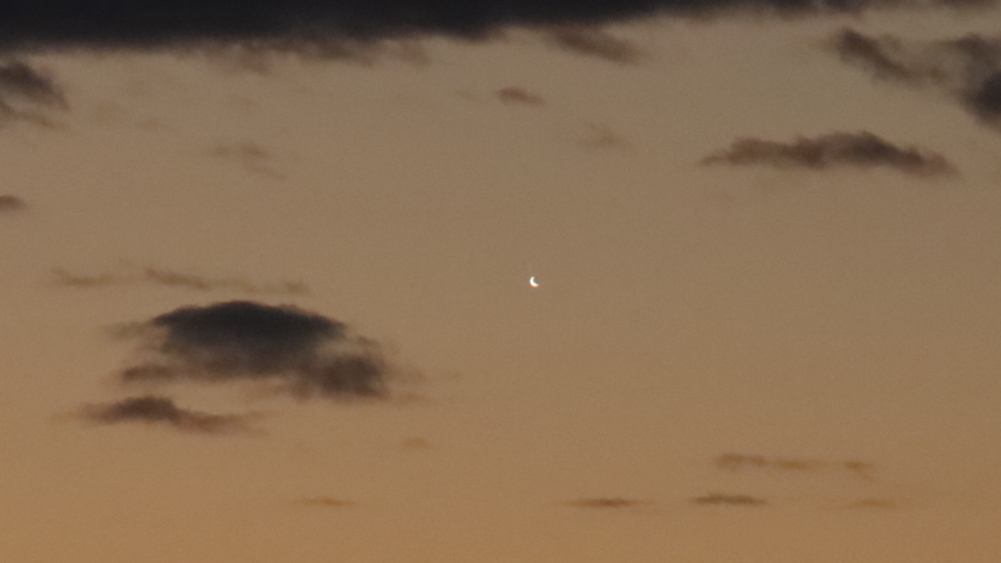
|
This image of
Crescent Venus was
also captured on
June 14, 2020, from Swede Run in Moorestown, NJ,
at 5:00 am EDT (3.4° altitude), using the same equipment as the previous
image, except for setting the focal length to 300 mm. It's a single raw frame exposed
1/320
second at f/5.6, ISO 6400 and daylight white balance. Using Canon's
Digital Photo Professional 4, no adjustments were made besides cropping
to 26% of the width x 22% of the height (to a 16:9 ratio) for a field 1.8° wide x
1.0° high, then finally resizing to 1000 x 563 pixels for this web page.
As is usually the case, the photographed Venus crescent looks
considerably thicker than its actual illumination (4.0% in this case).
|
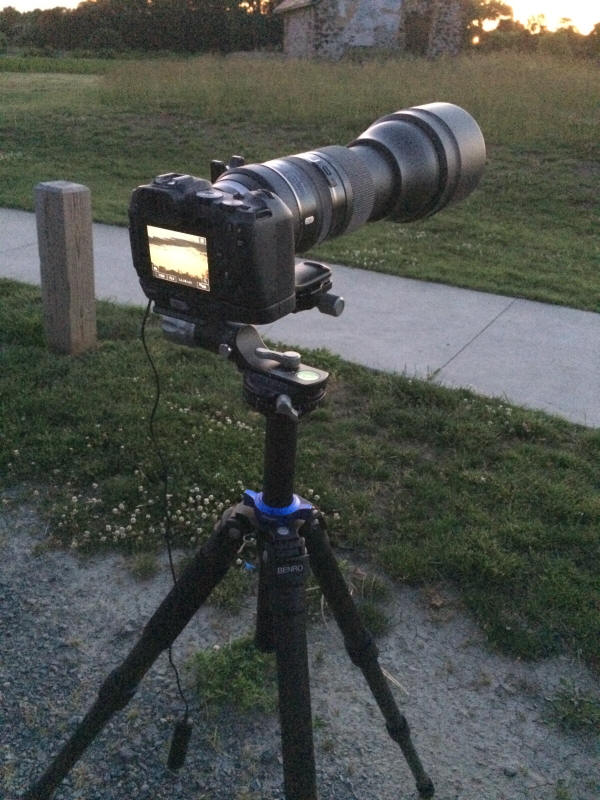
AR 2765 Sunspot Observed
June 9, 2020
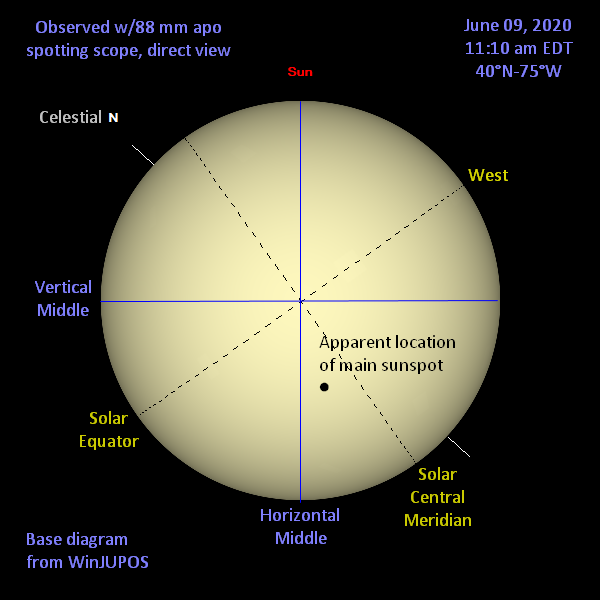
|
So far this year, the
Sun
has been devoid of sunspots more often than not. As of
June 9, 2020,
Spaceweather shows 122 spotless days, or 76% of the year so far. That
compares to a final tally of 281, or 77%, for 2019. Since sunspots have
been so infrequent recently, any sunspot draws attention, as is the
case for this group, AR 2765 (Active Region), which is primarily one
small, but distinct spot, plus a few scattered tiny spots. The
designation was applied when it appeared near the eastern limb (to the
left here) on June 4. I first observed the spot after looking at Venus
on June 7, about 2 pm EDT, with 15x56 binoculars (my first post inferior
conjunction view and the start of observing for this western
elongation). While I had the binoculars out, I used a Daystar white
light, film type of solar filter (left over from the 2017 total solar
eclipse) in front of the 15x56s to look at the sun. I was able to
clearly distinguish a small black dot.
I then looked on June 8 at
4:05 pm EDT and June 9 at
11:10 am with my Kowa 88 mm apo spotting scope using the same Daystar white
light filter, which is mounted in cardboard and folds into a cylinder that
slips over the objective end of a small scope (plus I use a strip of
gaffer's tape for a safety backup). On June 8, with the sun at about 48°
altitude, I used the standard 25 to 60x zoom eyepiece at 60x, while on
June 9, with the sun about 60° altitude, I added the 1.6x extender for a
maximum of 96X; however, with mediocre seeing, 64x offered the best
view. On both dates, the main dark spot looked relatively circular and
was surrounded concentrically by the penumbra. Careful inspection in
moments of better seeing revealed a few dark specks of lesser spots in
the group.
The diagram above is based on a
WinJUPOS representation of the sun for the June 9 observation. It's
set for a horizon orientation, so it matches the view in a spotting
scope with an erecting prism system. The dashed lines were generated by
WinJUPOS and show the solar equator and central meridian at the time, as
well as the direction of celestial north, which is not quite the same
direction as the sun's north pole. I added the solid lines dividing the
sun in half vertically and horizontally. I then added a black dot to
mark the position of the main sunspot as seen in the scope. Ultimately,
I wanted to see the spot's position with respect to the solar equator
(south of it) and central meridian (east of it).
Here's the SDO view (Solar
Dynamics Observatory) on June 9.
The
Sun was observed again on
June 12, 2020,
this time with an 80 mm William Optics Megrez apo refractor and a Lunt
Herschel wedge, using a 6.7 mm eyepiece for 72x. The diagonal of the
wedge resulted in a horizontal flip of the view. The diagram below of
the view on June 12 is reversed left-to-right compared to the diagram
above, plus there has been significant field rotation of the solar disc
because it was observed almost 5 hours later in the day. The main
sunspot is marked in the apparent
position as seen in the
eyepiece, and in each diagram, mouseover brings up a rose-colored arrow
showing the spot's path due to solar rotation (it moves east to west,
parallel to and south of the solar equator). The spot showed nicely in
the 80 mm refractor, with a blackish umbra and radial darkish lines for
the penumbra. However, despite the improved view with the Herschel
wedge, no secondary spots were seen.
|
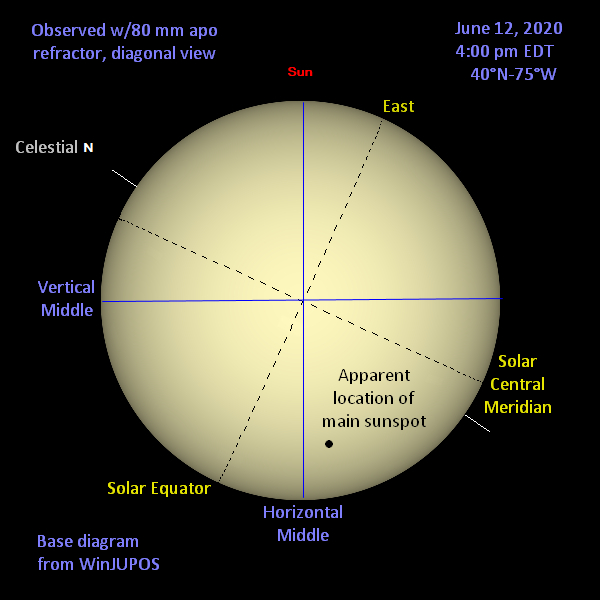
Venus and Mercury
May 15, 2020
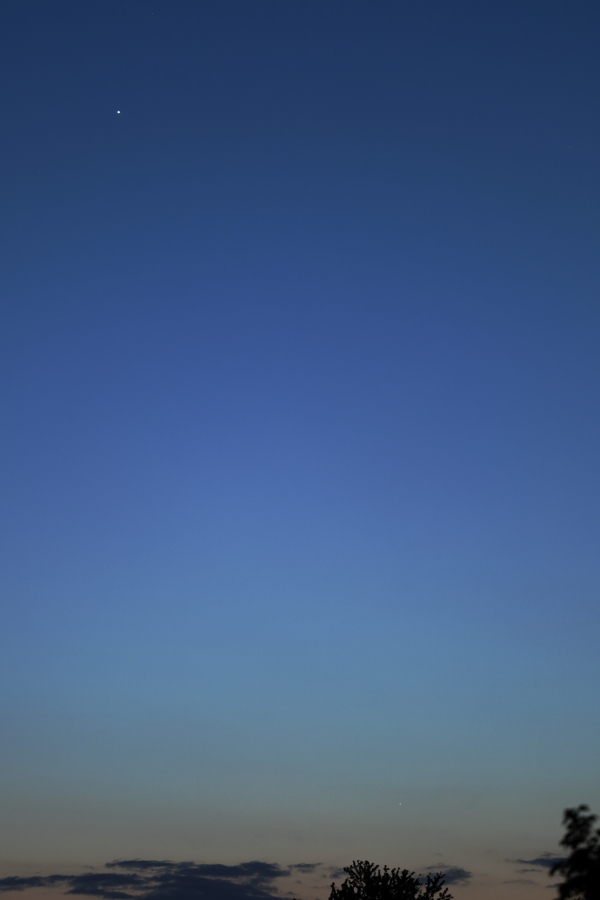
|
The planet
Venus, blazing at
magnitude -4.4, was joined by its fellow interior planet, magnitude -1.1
Mercury,
on
May 15, 2020, when this image of them was captured
at 8:42 pm EDT from Collins Lane Park in Maple Shade,
NJ, with a Canon EOS RP mirrorless digital camera and a Canon 100 mm
f/2.8L macro lens (on a fixed tripod). It's a single raw frame exposed
1/8
second at f/2.8, ISO 200 and daylight white balance. Brightness and
contrast were mildly adjusted, it was cropped to 79% of the
original linear dimensions for a field 10.9° wide x 19.0° high, then
finally resized to 600 x 900 pixels in Canon's Digital Photo
Professional for this web page. Mouseover for labels.
The image below is a separate DPP crop & resize of the image
above to better show Mercury; the field is 5.9° wide x 3.4° high.
|
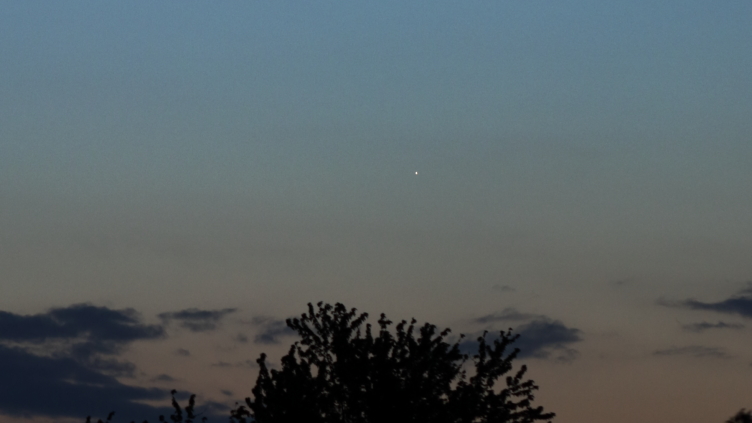
|
At the time of the image,
Venus was a slim
crescent, 11% illuminated and 50 arc seconds diameter, nineteen days
before inferior conjunction on June 3, 2020. It was also observed
visually with an 88 mm apo spotting scope at 60x, which nicely showed
the thin, bright crescent, reminiscent of a fingernail clipping. Earlier in
the day, at 3:20 pm, Venus was spotted in full daylight, 26.6° from the
sun, with 10x50 binoculars.
Mercury, the speedy
Winged Messenger, was at superior conjunction on May 4, 2020, will reach
greatest eastern elongation on June 4, then inferior conjunction on June
30. At the time of the photo, Mercury was about 13° from the sun, 85% illuminated and 5.6 arc seconds
diameter. In the spotting scope, it was just a bright dot (too small and
too low in the sky to show any shape or detail). This sighting marks the
60th elongation in a row that I've spotted Mercury, starting in January
2011.
For those in Southern New Jersey, Venus and Mercury will be close
together on the evenings of May 21 and 22. At 8:30 pm EDT on
May 21, Mercury will be 1.2° from Venus at the 7 o'clock position. On
May 22 at 8:30 pm, Mercury will be 1.6° from Venus at the 10 o'clock
position. By then, Mercury will have dimmed to magnitude -0.6 on May 21
and -0.5 on May 22, but higher in the sky at 13° and 14° altitude
respectively, so it should be easier to see (weather permitting). The
planetary pair
will make a fine sight to the unaided eye, let alone binoculars or even a
small scope.
|
The Crescent Venus
May 2, 2020
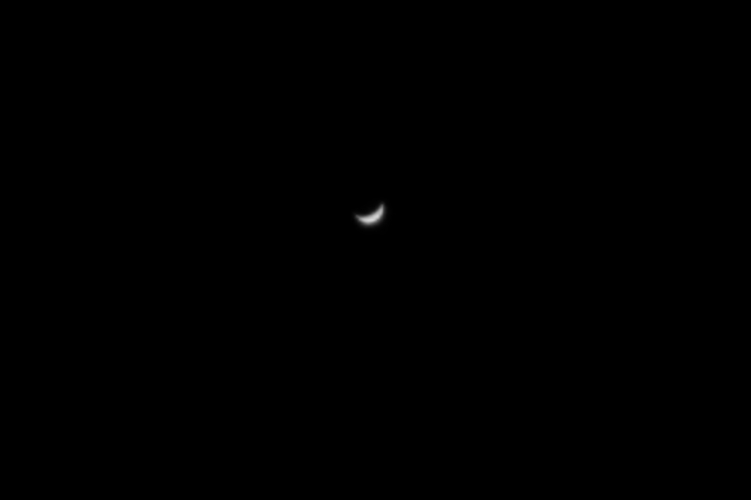
|
The planet
Venus was a 23% crescent
on
May 2, 2020, when this image of it was captured
at 9:24 pm EDT from Collins Lane Park in Maple Shade,
NJ, with a Canon EOS RP mirrorless digital camera and a Tamron SP 150 to
600 mm f/5-6.3 zoom lens (on a fixed tripod) set to 600 mm focal length. It's
a single raw frame exposed 1/2000
second at f/6.3, ISO 6400. To show the crescent, just a speck on the
original frame, the image was severely cropped to 8.0% of the original
linear dimensions, yielding a field 0.27° wide x
0.18° high. At the time, Venus was 40.2 arc seconds diameter, 37° solar
elongation and 18° altitude in the WNW. Some mild adjustments were made
to the brightness, the white
balance was set to monochrome and the 500 x 333 cropped raw frame was
resized and converted to this 750 x 500 JPEG in Canon's Digital Photo
Professional. The crescent was also observed visually with an 88 mm apo
spotting scope at 60x.
Here's a
WinJUPOS
synthetic image showing a direct
view of Venus (including the normally invisible non-illuminated portion)
for the same date, time and location as the image above.
|
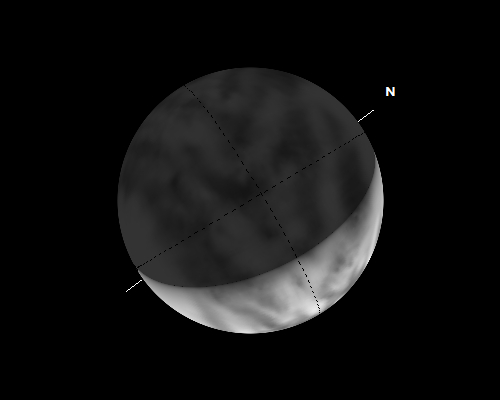
Venus Moves East of the Pleiades
April 6, 2020
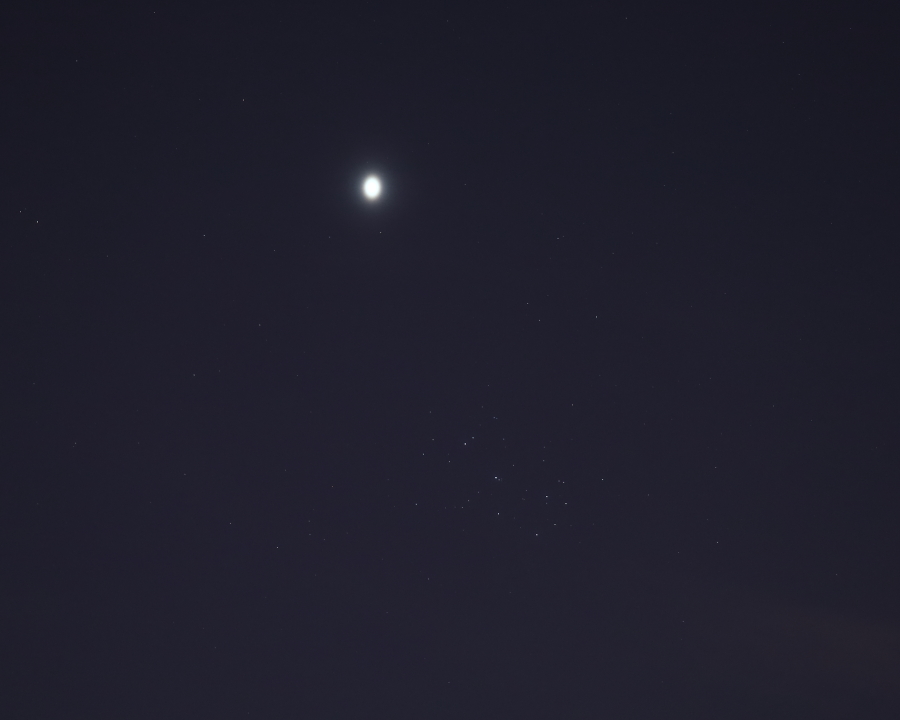
|
On
April 6, 2020, the planet
Venus had moved 2.7° east
of Alcyone in the
Pleiades,
the open star cluster also known as
Messier 45 or the
Seven Sisters. This image of them was captured
at 9:25 pm EDT under a hazy sky from Collins Lane Park in Maple Shade,
NJ, with a Canon EOS RP mirrorless digital camera and a Canon 200 mm f/2.8L
telephoto lens (on a fixed tripod) when Venus was at 21° altitude. It's
a single raw frame exposed 1/2
second at f/2.8, ISO 1600 (auto exposure minus 1.7
stops). The image was cropped to a 5:4 ratio for a field 7.4° wide x
5.9° high. After some mild adjustments to the contrast and setting white
balance to 4000K, the raw frame was converted to a JPEG in Canon's Digital Photo
Professional. Mouseover for labels.
|
Venus Joins the Pleiades
April 3, 2020
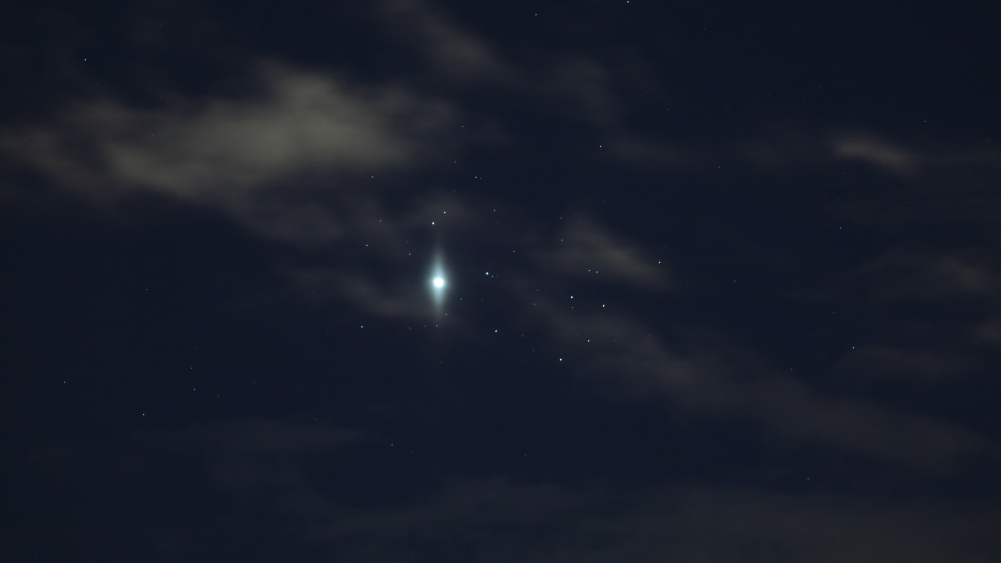
|
On
April 3, 2020, the planet
Venus mingled with the
Pleiades,
the open star cluster also known as
Messier 45 or the
Seven Sisters (plus the two parents, Atlas
and Pleione). Unexpectedly, around 10 pm
EDT, I noticed the sky had cleared somewhat and Venus was visible
(through tree branches) out my back window, so I dashed to the local
baseball field complex in Maple Shade, NJ. Venus was obvious to unaided
eyes, but seeing the Pleiades required assistance from my 10x42
binoculars, and it was a fine sight! This image of them was captured
(through clouds and haze) at 10:22 pm with a Canon EOS RP mirrorless digital camera and a Canon
400 mm f/5.6L
telephoto lens (on a fixed tripod) when Venus was at 10.5° altitude. It's a single raw frame exposed
0.6
second at f/5.6, ISO 3200 (auto exposure minus 2 stops). Keeping the
full width, the image was cropped
to a 16:9 ratio for a field 5.1° wide x
2.9° high. After some mild adjustments to the brightness and white
balance, the raw frame was converted to a JPEG in Canon's Digital Photo
Professional. Mouseover for labels.
Here's a page comparing this
picture of Venus in the Pleiades with a similar one from 2012 by another
photographer.
|
Venus Approaches the Pleiades
April 1, 2020
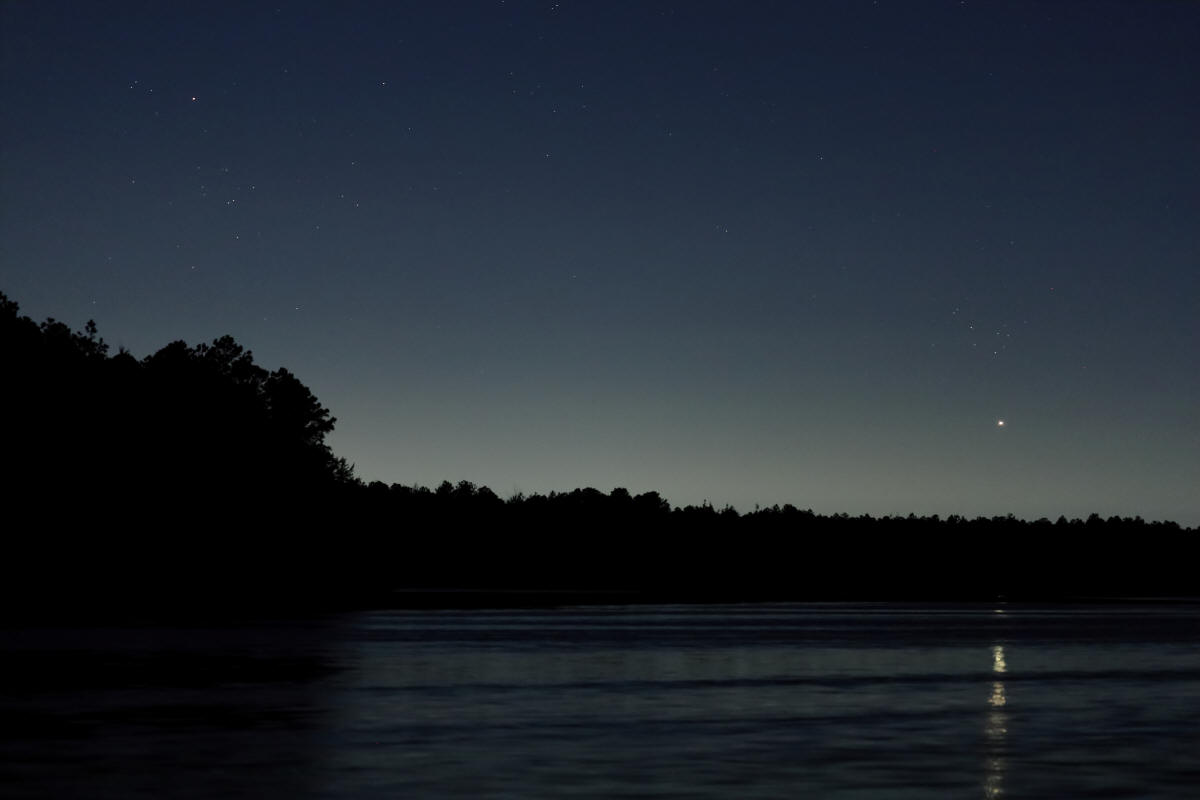
|
On
April 1, 2020, the planet
Venus
is
approaching the
Pleiades,
the open star cluster also known as
Messier 45 or the
Seven Sisters. Venus
is above the trees on the right at about 3° altitude, while the
Hyades star cluster
is above the trees on the left, as seen looking over Chatsworth Lake in
the New Jersey Pines (about 34 miles ESE of Philadelphia City Hall). The
bright first-quarter moon was 52° above-left of Venus
(outside the frame). This image was captured at 11:07 pm EDT with a Canon EOS RP mirrorless digital camera and a Canon
100 mm f/2.8L
macro lens (on a fixed tripod). It's a single raw frame exposed 1
second at f/2.8, ISO 2000. The image is uncropped for a field 20.4° wide x
13.7° high. The original raw frame was
set to tungsten white balance, mildly adjusted for brightness and
contrast and then converted to a JPEG in Canon's Digital Photo
Professional.
Mouseover for labels.
|
Click here
for the previous page.
Click here
for an index to previous SJAstro pages.
















